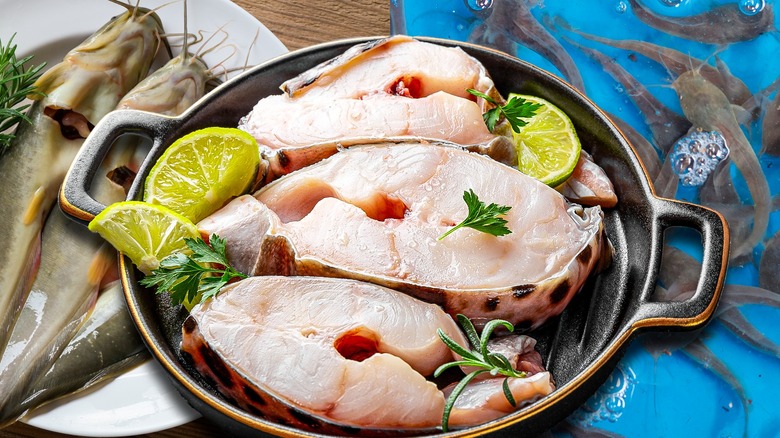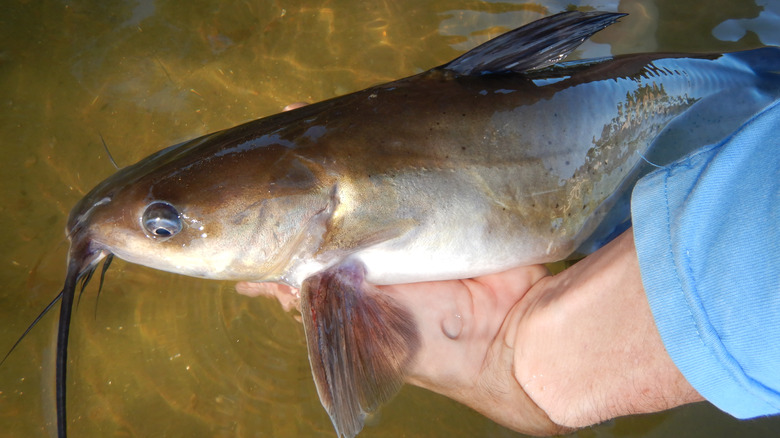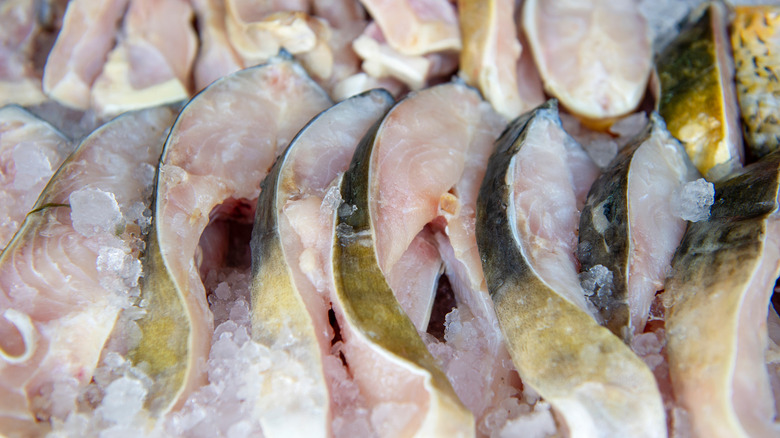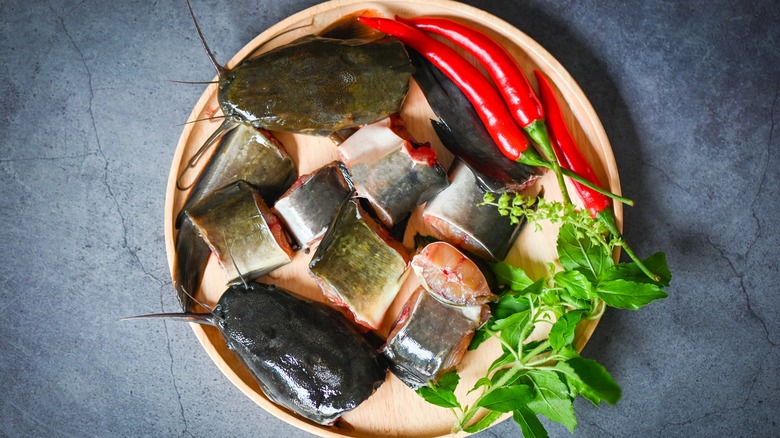What Are Catfish Steaks And What's The Best Way To Cook Them?
Catfish is a popular catch for fishermen and a common sight in fishmongers' shops and your local supermarket. Ordinarily, at stores, you'll see it in filet form, which is familiar and easy to work with, but occasionally, you may also see catfish steaks. Those may be less familiar to you and require a bit of explanation.
A catfish steak is still the fish you already know and love, but it's used differently. Don't try putting one in a sandwich, for instance! While they're cut from the same fish, steaks and filets are physically different, so buying your catfish in steak form will require some mental adjustments if you haven't worked with them before.
I have: I'm a trained chef who has owned and operated a pair of fish-forward restaurants. I'm also descended from generations of fishermen. With that in mind, here's what you need to know about catfish steaks and how to cook them.
What are catfish steaks?
A "steak" of fish is more or less the opposite of a filet. Filets are cut lengthwise from a fish, while steaks are cut crosswise instead. They're usually taken from the belly area, where the fish is at its largest, and cut to a thickness that's usually at least half an inch. They're a bigger cut and — for lack of a better word — meatier.
This crosswise cut is a pragmatic and frugal option because of its simplicity. It takes minimal time and skill to cut steaks — perfect for those who catch their own catfish. There's also minimal waste because you're leaving no meat behind on the bones, which is appealing if you're buying whole catfish by the pound.
You won't see steaks as often as filets, but they're still a common cut of fish. Depending on where you live, you'll mostly see salmon or halibut cut this way, but catfish is something that may turn up occasionally. If you do see catfish steaks, they're worth trying because they're suited to some preparations that filets aren't.
How are catfish steaks cut?
When you're cutting steaks rather than filets, you'll start by cutting through the body to remove the section right behind the gills. On larger fish, that's a cut in itself, called the collar.
The next step is to slice straight through the catfish again, from side to side, at the thickness you've chosen for your steak. You may get several steaks or just a few, depending on the size of the fish and how thick you like your steaks. Once you reach the area where your steaks are too small to make a full portion, you can either filet the rest or keep it intact and cook it whole.
With catfish or any other round fish, we find that the best steaks come from ones that are 3 to 6 inches in diameter, from the dorsal fin in the back to the belly. Steaks cut from a fish that size make a reasonable portion for one person. Large, wild-caught catfish may be too big for this method, but their tail sections can make a normal-sized steak, or they can be "steaked" in the same way as tuna or swordfish. In that case, a loin is first cut from the fish and then sliced crosswise into steaks.
What kind of catfish are steaks cut from?
Two kinds of catfish account for almost all of the U.S. market. Most of what you see at stores is farmed channel catfish, also known as Ictalurus punctatus, which is the most important aquaculture species in America, according to the U.S. Department of Agriculture (USDA).
Per USDA, channel catfish account for 90% of the farmed catfish sold in the U.S., while blue catfish, also known as Ictalurus furcatus, is common, too. Blue catfish are meatier than channel catfish but slower-growing, which makes them less suitable for aquaculture. Although some buyers reflexively avoid farmed fish, there aren't a lot of practical differences between farmed and wild catfish. If anything, farmed catfish may be the superior choice because the flavor of wild-caught fish can be variable.
You'll also see some Asian catfish in stores. They're from the Pangasius group of catfish species, which differ from American species. Under American labeling law, only the native Ictalurus species can be sold as just plain "catfish," so these Asian cousins are sold under names like basa and swai. Those will rarely, if ever, turn up as steaks.
Is catfish a sustainable option?
Some of you may avoid farmed fish on principle because it has a sometimes-deserved reputation for poor environmental standards. Environmental organizations like Greenpeace especially criticize open-net pens in natural bodies of water.
Yet, the Monterey Bay Aquarium's Seafood Watch program recommends farmed channel catfish from the U.S. as a "Best Choice" — its highest rating. They're grown in landlocked ponds — not open-water pens — that function as artificial wetlands, and the industry is tightly regulated in its use of chemicals and antibiotics. Seafood Watch's Sustainable Catfish Guide also ranks blue catfish from Chesapeake Bay highly as either a "Best Choice" or "Good Alternative," depending on how it was harvested.
Imported Asian catfish doesn't score nearly as well because of significant concerns around chemical use and aquaculture methods in China and Vietnam. A small number of Vietnamese producers are certified to produce their catfish in an environmentally sustainable fashion, earning higher marks.
How are catfish steaks different from filets?
Catfish filets are familiar and uncomplicated, just a flat strip of flesh cut lengthwise from the side of the fish, from head to tail. Some suppliers trim away the thinnest part, around the belly, to give the finished filet a neater appearance. We've done this in restaurants, where presentation is important. They're also typically sold skinless and boneless.
On the contrary, catfish steaks include both skin and bone, which can be a mixed blessing: Diners are minorly inconvenienced by having to remove them at the table, but they're a positive for the cook. Fish with bones and skin tend to stay more moist, and we find that the skin adds richness and body to fish soups and stews.
Catfish steaks' chunkier structure is another important difference. Filets of catfish and other soft-fleshed fish are fragile, and we've observed they don't hold up under rough handling. Because of their thickness, catfish steaks are sturdier and stand up nicely to grilling, pan-frying, or even soups, where a filet would normally fall apart.
Where (and how) to buy catfish steaks
Catfish filets are readily available almost anywhere you buy fish, but catfish steaks can be harder to seek. The most reliable way to find them is to catch your own catfish and "steak" them personally. If fishing isn't your thing, check with your favorite local fishmonger. They can often bring in whole catfish and cut them into steaks to order. If your local supermarket has a good supply chain, they may also be able to order them in.
If you struggle to source catfish steaks in your area, shopping online is the next obvious option. Unfortunately, while catfish filet and nuggets are plentiful from online suppliers, catfish steaks decidedly are not. The most visible supplier is Mississippi-based Simmons Farm Raised Catfish, but if you live in or near a state where catfish are farmed, you may be able to buy steaks from one of your local producers.
If those options don't work out, try emailing or calling a few online vendors. The ones with regular access to catfish may be willing to cut a batch of steaks for you as a special order or sell you a whole catfish that you can cut up yourself.
How to store catfish steaks
After you've purchased or cut a batch of catfish steaks, it's time to decide whether to eat them immediately or store them for another day. If you've bought your catfish steaks frozen, it's an easy call: Just pop them into the freezer if you aren't cooking them tonight. According to the USDA, frozen catfish will stay food safe indefinitely, though quality may suffer if freezing for longer than two months in the original plastic porous packaging.
Catfish you've bought fresh or caught yourself should be cooked and eaten as soon as possible, ideally within a day or two. If not, freezing it will be the way to go.
Once it's cooked, the USDA suggests eating any leftover catfish within three to four days or freezing it as soon as possible for later meals. This advice assumes that you've followed the agency's food safety basics throughout the buying and cooking process, including keeping your catfish at food-safe temperatures and avoiding cross-contamination. Any food-handling errors can shorten the catfish's safe storage life.
Are there advantages to buying catfish as steaks?
Catfish filets are the default option, and if you're a fish lover, you probably have experience with them. Still, there are a few advantages to buying your catfish as steaks instead.
For one thing, their added thickness makes it harder to overcook your fish. With thin filets, it can happen in the blink of an eye. Another consideration is that many traditional fish recipes — European and especially Asian — call for cuts with skin and bone included; our infatuation with "skinless and boneless" is relatively recent. In those cases, you can't make an authentic version of the dish with a boneless filet.
A further big advantage of steaks is their relative sturdiness. Catfish is a soft-fleshed fish without the density and sturdiness of tuna, swordfish, or even halibut and salmon. This makes catfish filets fragile and easy to break, exactly the type of fish you should avoid grilling or even pan-frying without the traditional coating of cornmeal or breadcrumbs. Catfish steaks, on the other hand, excel in those scenarios. For some, there's also something innately satisfying about sitting down to a big, meaty slab of fish.
Are there any disadvantages to catfish steaks?
Nothing in life is perfect, and there are reasons why fish steaks are less popular than filets. Arguably, the most important is that filets are hassle-free for cooks and diners alike: easy to find, easy to cook, and easy to eat.
We find that some diners won't want to deal with skin or bones, though they aren't hard to remove or eat around as long as you know where they are. You can feel the pin bones with a fingertip before cooking the steaks, so if you remember the spot, it's easy to remove that small area with your fork and set it aside while you eat. Your steaks may even come from the tail portion of a larger catfish, in which case you'll only have the spine to worry about.
If you have catfish steaks with the ribs and pin bones included, consider deboning and rolling them. It's very much the same process as rolling salmon steaks before grilling, something that we've done personally as a farmer's market vendor. It's a bit of extra prep with your catfish steaks, but you and your guests won't have to worry about bones during the meal. It looks neater, too.
How to cook with catfish steaks
If you're used to just coating your catfish in cornmeal and frying it, catfish steaks will open up some additional options. For inspiration, consult a list of different ways to cook fish and look for methods you haven't used with catfish filets because of their fragility.
The standout option is grilling because most of us love to grill, and catfish filets aren't well suited for that cooking method. Marinate your steaks first or brush them with herbs and oil, then slap them onto that flame! We also find steaks excellent under a broiler, preferred for when it's too cold or stormy for grilling outdoors.
Catfish steaks also work well for pan-frying, baking, simmering in a tasty sauce, or serving whole as an eye-catching garnish in a bowl of soup. They're also ideal for preparing en papillote, the classic French technique of cooking fish in a pouch of parchment paper. Catfish steaks are less common than salmon or halibut steaks, so you may struggle to find catfish-specific recipes online, but that's okay. You can easily adapt recipes intended for salmon, halibut steaks, or filets of thicker white fish like cod.
Mistakes to avoid when cooking catfish steaks
In our cooking classes, we used to joke that there were just three rules for fish: "Don't overcook it, don't overseason it, and don't overthink it." In truth, with a mild white fish like catfish, there's room to flex on the seasoning rule.
It's okay to keep it simple with just salt and pepper or a fresh herb of your choice and leave the focus on the catfish's natural flavor. It's also fine to serve the steaks in a bold-flavored sauce — perhaps something Italian, Thai, or spicy — because the thickness of the steaks creates a pleasant contrast between the flavored exterior and the mild interior. However, if you're an inexperienced cook, you can run into problems when improvising with too many flavors. Keep it simple instead, and try only one new thing at a time.
Overcooking is a bigger problem because you can scrape off seasonings, but you can't un-cook things. A perfectly cooked white fish isn't completely white all the way through and should have a hint of pearly near-translucence in the middle.
You can't know for sure without cutting into it or using a good instant-read thermometer, and thermometers are by far the more reliable option. The USDA recommends cooking catfish to 145 degrees F, though some chefs consider 140 degrees ideal.
Are catfish steaks healthy food?
The federal government's Dietary Guidelines for Americans recommend eating at least two servings of fish or other seafood weekly, and they specifically call out catfish as an option that's low in mercury, which is an issue with many fish.
Aside from being low in mercury, catfish have a lot more to offer. Figures from the USDA's FoodData Central show catfish to be low in calories, packed with lean protein, a really good source of vitamins B1 and B12, and also high in minerals such as selenium, phosphorus, and potassium.
It even contains useful quantities of omega-3 and omega-6 fatty acids, though as a lean fish, it contains less than oilier fish such as salmon, mackerel, or sardines. You'll want to occasionally eat those richer fish as well, but catfish holds its own as part of a nutritious eating plan. Combine that with its status as an environmentally sustainable choice, and it's a great mealtime option.
Recipe suggestions for catfish steaks
There aren't a huge number of recipes out there for catfish steaks because of their relative rarity, but we can recommend a few to inspire you and get you started. If you love to grill, for example, it would be easy to adapt this recipe for grilled salmon steaks with cumin mayo to use catfish instead. It's a simple recipe, and if anything, the mayonnaise may work better with lean catfish than rich salmon.
Another recipe that lends itself to catfish steaks is this one for halibut pockets with spiced olive tapenade. It draws on a classic French technique — cooking en papillote — and a classic French Mediterranean spread or condiment — the tapenade. Catfish will complement those flavors nicely.
Catfish are also widely used in Asian cuisine, which opens up a whole other spectrum of flavors for your enjoyment. If your favorite restaurants and takeouts all hail from that part of the world, consider trying these recipes for Canh Chua Cá, a sweet and spicy Vietnamese soup, or clay pot catfish with pickled carrots and cucumbers.
Static Media owns and operates Tasting Table, Mashed, The Daily Meal, and Food Republic.













